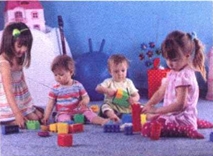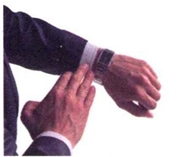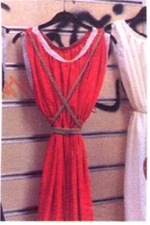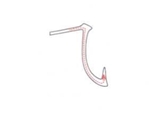3 用本课新学的语言点和词语描述图片
Describe the pictures using the newly-learned language points and words.

Wàimiɑn xiàyǔ, tāmen dōu zài lǐ ne.
外面 下雨,他们 都 在 里呢。

Lǐ xiānsheng de shǒubiǎo hěn hǎo , sān duō kuài qián.
李 先生 的 手表 很 好 , 三 多 块 钱。

Wǒ juéde zuǒbiān nàge de piàoliɑng.
我 觉得 左边 那个 的 漂亮。

Jīntiān niúnǎi de lái le ,
今天 牛奶 的 来了,
bào zhǐ de méi lái.
报纸 的 没来。
语音 Pronunciation
四音节词语的重音 Stress in Quadrisyllabic Words 03-5
(1)不含轻声音节的四音节词语 Quadrisyllabic Words without a Neutral Tone
四音节词语的重音一般在第四个音节。例如:
In a quadrisyllabic word, the stress generally falls on the fourth syllable. For example:
gōnggòng qìchē 公共 汽车 车
gāosù gōnglù 高速 公路 路
míngshèng gǔjì 名胜 古迹 迹
ài bù shì shǒu 爱不释 手 手
(2) 含轻声音节的四音节词语 Quadrisyllabic Words with a Neutral Tone
含有轻声音节的四音节词语一般为形容词,第二个音节一般为轻声音节,第四个音节为重读音节。例如:
A quadrisyllabic word that has a neutral-tone syllable is usually an adjective, in which the second syllable is in the neutral tone and the fourth syllable is stressed. For example:
汉字 Characters
1 汉字的笔画(9):㇈、㇂
Strokes of Chinese Characters (9): ㇈、㇂
| 笔画名称 Stroke | 运笔方向 Direction | 例字 Example Characters |
|---|---|---|
| 横折斜钩 ㇈ héngzhéxiégōu Horizontal-Turning-Slanting Hook |
 |
飞 fēi to fly 风 fēng wind |
| 弯钩 ㇂ wāngōu Crooked Hook |
 |
狗 gǒu dog 猫 māo cat |
2 认识独体字 Single-Component Characters
(1)“手”,字形是一只手的形象,表示“手”的意思。
The original form of “手” is an image of a hand. It means “hand”.

(2)“丈”,本义是手持拐杖的老者,现在是长度单位。
“丈” originally referred to an old person holding a walking stick. Now it is a unit of length.

(3)“夫”,本义是成年男子,现在多指家庭中的男性、丈夫。
“夫” originally referred to an adult man. Now it usually means “a man or husband in a family”.

3 汉字偏旁“木”和“刂” Chinese Radicals: “木” and “刂”
| 偏旁 Radical |
解释 Explanation |
例字 Example Characters |
|---|---|---|
| 木 | 木字旁,一般和植物有关系。 The radical “木” is usually related to plants. |
杯 bēi cup, glass 椅 yǐ chair |
| 刂 | 立刀旁,一般和刀有关系。 The radical “刂” is usually related to cutters or knives. |
别 bié to leave, to part 到 dào to arrive |
运用 Application
1 双人活动 Pair Work
两人一组,把几个同学的笔、书、杯子等物品放在一起,然后通过询问确定哪个物品是哪位同学的。
Work in pairs. Put together several classmates’ items, such as pens, books and cups, etc. Identify the owner of each item by asking questions.
例如:
Zhège hóngsè de bēizi shì nǐ de ma?
A: 这个 红色 的杯子是你的吗?
Bú shì wǒ de.
B: 不是 我的。
Pángbiān fěnsè de bēizi shì nǐ de ma?
A: 旁边 粉色 的杯子是你的吗?
Shì wǒ de.
B: 是 我的。
| 物品 Item |
杯子 bēizi |
笔 bǐ |
书 shū |
报纸 bàozhǐ |
钱 qián |
|---|---|---|---|---|---|
| 位置 Position |
左边 zuǒbian |
右边 (yòubian, right) |
前边 qiánbian |
后边 hòubian |
旁边 pángbian |
| 颜色 Color |
红色 hóngsè |
粉色 fěnsè |
(báisè, white) | (hēisè, black) | (lánsè, blue) |
3~4人一组,边画边介绍你家的房间。
Work in groups of 3 – 4. Describe the rooms in your house or apartment while drawing the pictures of them.
Zuǒbian de fángjiān shì wǒ bàba māma de,tāmen de fángjiān hěn dà.
例如:左边 的 房间 是我爸爸妈妈的,他们 的 房间 很大。
Pángbiān de shì wǒ de,wǒ de fángjiān shì fěnsè de.
旁边 的是我的,我的 房间 是粉色的。
Diànnǎo zài zhuōzi shang,zhuōzi zài chuáng pángbiān.
电脑 在 桌子 上,桌子在 床(bed) 旁边。

Comments